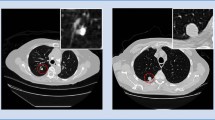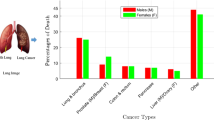Abstract
Purpose
Considering that false-positive and true pulmonary nodules are highly similar in shapes and sizes between lung computed tomography scans, we develop and evaluate a false-positive nodules reduction method applied to the computer-aided diagnosis system.
Methods
To improve the pulmonary nodule diagnosis quality, a 3D convolutional neural networks (CNN) model is constructed to effectively extract spatial information of candidate nodule features through the hierarchical architecture. Furthermore, three paths corresponding to three receptive field sizes are adopted and concatenated in the network model, so that the feature information is fully extracted and fused to actively adapting to the changes in shapes, sizes, and contextual information between pulmonary nodules. In this way, the false-positive reduction is well implemented in pulmonary nodule detection.
Results
Multi-path 3D CNN is performed on LUNA16 dataset, which achieves an average competitive performance metric score of 0.881, and excellent sensitivity of 0.952 and 0.962 occurs to 4, 8 FP/Scans.
Conclusion
By constructing a multi-path 3D CNN to fully extract candidate target features, it accurately identifies pulmonary nodules with different sizes, shapes, and background information. In addition, the proposed general framework is also suitable for similar 3D medical image classification tasks.






Similar content being viewed by others
References
Siegel RL, Miller KD, Jemal A (2018) Cancer statistics. CA Cancer J Clin 60(suppl 12):277–300
Tarver T (2012) American cancer society cancer facts and figures 2014. Journal of Consumer Health on the Internet 16(3):366–367
Kaneko M, Equchi K, Ohmatsu H, Kakinuma R, Naruke T, Suemasu K, Moriyama N (1996) Peripheral lung cancer: screening and detection with low-dose spiral CT versus radiography. Radiology 201(3):798–802
Miettinen OS, Henschke CI (2011) CT screening for lung cancer: coping with nihilistic recommendations. Radiology 221(3):592–596
Henschke CI (2001) Early lung cancer action project: overall design and findings from baseline screening. Cancer 354:2474–2482
Messay T, Hardie RC, Rogers SK (2010) A new computationally efficient CAD system for pulmonary nodule detection in CT imagery. Medical Image Anal 14(3):390–406
Jacobs C, Van Rikxoort EM, Twellmann T, Scholten ET, De Jong PA, Kuhnigk JM (2014) Automatic detection of subsolid pulmonary nodules in thoracic computed tomography images. Med Image Anal 18(2):374–384
Chen Y, Liu C, Peng W, Xia S (2017) Thyroid nodule detection using attenuation value based on non-enhancement CT images. In: 2nd IET international conference on biomedical image and signal processing
Lu L, Tan Y, Schwartz LH, Zhao B (2015) Hybrid detection of lung nodules on ct scan images. Med Phys 42(9):5042–5054
Paing MP, Choomchuay S (2017) A computer aided diagnosis system for detection of lung nodules from series of CT slices. In: International conference on electrical engineering/electronics. IEEE, pp 302–305
Gupta A, Martens O, Le Moullec Y, Saar T (2015) Methods for increased sensitivity and scope in automatic segmentation and detection of lung nodules in CT images. In: Proceedings of the IEEE international symposium on signal processing information technology, pp 375–380
Setio AAA, Jacobs C, Gelderblom J, Ginneken BV (2015) Automatic detection of large pulmonary solid nodules in thoracic ct images. Med Phys 42(10):5642–5653
Murphy K, van Ginneken B, Schilham AMR, de Hoop BJ, Gietema HA, Prokop M (2009) A large-scale evaluation of automatic pulmonary nodule detection in chest ct using local image features and k-nearest-neighbour classification. Med Image Anal 13(5):757–770
Firmino M, Morais AH, MendoA RM, Dantas MR, Hekis HR, Valentim R (2014) Computer-aided detection system for lung cancer in computed tomography scans: review and future prospects. Biomed Eng Online 13(1):41
Abbosh C, Birkbak NJ, Swanton C (2017) Phylogenetic ctDNA analysis depicts early-stage lung cancer evolution. Nature 545(7655):446–451
Dou Q, Chen H, Lequan YU, Zhao L, Heng PA (2016) Automatic detection of cerebral microbleeds from mr images via 3d convolutional neural networks. IEEE Trans Med Imaging 35(5):1–1
Abdelhafiz D, Yang C, Ammar R, Nabavi S (2019) Deep convolutional neural networks for mammography: advances, challenges and applications. BMC Bioinform 20(Suppl 11):281
Xiao Z, Du N, Geng L, Zhang F, Liu Y (2019) Multi-scale heterogeneous 3d cnn for false-positive reduction in pulmonary nodule detection, based on chest ct images. Appl Sci 9(16):3261
Setio AAA, Ciompi F, Litjens G, Gerke P, Jacobs C, Riel SJV, Wille MMW, Naqibullah M, Sanchez CI, Ginneken BV (2016) Pulmonary nodule detection in ct images: false positive reduction using multi-view convolutional networks. IEEE Trans Med Imaging 35(5):1160–1169
Armato S, Mclennan G, McNittray M, Meyer C, Clarke L (2010) the lung image database consortium and image database resource initiative: a completed public database of ct scans for lung nodule analysis. Med Phys 37(6):3416–3417
Sori WJ, Feng J, Liu S (2019) Multi-path convolutional neural network for lung cancer detection. Multidim Syst Signal Process 30:1749–1768
Dou Q, Chen H, Yu L, Qin J, Heng PA (2016) Multi-level contextual 3d cnns for false positive reduction in pulmonary nodule detection. IEEE Trans Biomed Eng 64:1558–1567
Setio A, Traverso A, Jacobs C et al (2016) Validation, comparison, and combination of algorithms for automatic detection of pulmonary nodules in computed tomography images: the LUNA16 challenge. Med Image Anal 42:1–13
Xie H, Yang D, Sun N, Chen Z, Zhang Y (2018) Automated pulmonary nodule detection in CT images using deep convolutional neural networks. Pattern Recognit 85:109–119
Armato SG, Petrick NA, Lee H (2017) Contextual convolutional neural networks for lung nodule classification using Gaussian-weighted average image patches. In: Proceedings of the SPIE, vol 10134, id. 1013423
Roth HR, Lu L, Liu J, Yao J, Seff A, Cherry K, Kim L, Summers RM (2016) Improving computer-aided detection using convolutional neural networks and random view aggregation. IEEE Trans Med Imaging 35:1170–1181
Ding J, Li A, Hu Z, Wang L (2017) Accurate pulmonary nodule detection in computed tomography images using deep convolutional neural networks. Medical Image Comput Comput Assisted Inter 10435:559–567
Cao H, Liu H, Song E, Ma G, Xu X, Jin R, Liu T, Hung CC (2019) Multi-branch ensemble learning architecture based on 3d cnn for false positive reduction in lung nodule detection. IEEE Access 7:1–1
Zhang Z, Li X, You Q, Luo X (2019) Multicontext 3d residual cnn for false positive reduction of pulmonary nodule detection. Int J Imaging Syst Technol 29(1):42–49
Kim BC, Yoon JS, Choi JS, Suk HI (2019) Multi-Scale gradual integration CNN for false positive reduction in pulmonary nodule detection. Neural Netw 115:1–10
Acknowledgements
This research work is supported by National Natural Science Foundation of China (61001049), Beijing Natural Science Foundation (4172010).
Author information
Authors and Affiliations
Corresponding author
Ethics declarations
Conflict of interest
The authors declare that they have no conflict of interest.
Ethical approval
This article does not contain any studies with human participants performed by any of the authors.
Informed consent
Informed consent was obtained from all individual participants included in the study.
Additional information
Publisher's Note
Springer Nature remains neutral with regard to jurisdictional claims in published maps and institutional affiliations.
Rights and permissions
About this article
Cite this article
Yuan, H., Fan, Z., Wu, Y. et al. An efficient multi-path 3D convolutional neural network for false-positive reduction of pulmonary nodule detection. Int J CARS 16, 2269–2277 (2021). https://doi.org/10.1007/s11548-021-02478-y
Received:
Accepted:
Published:
Issue Date:
DOI: https://doi.org/10.1007/s11548-021-02478-y




